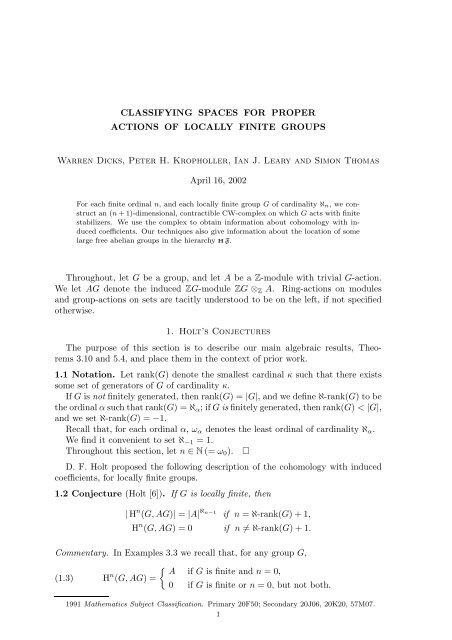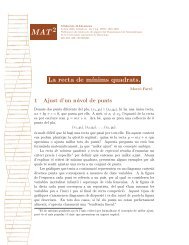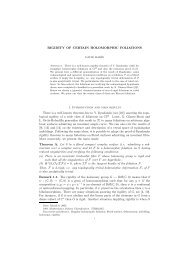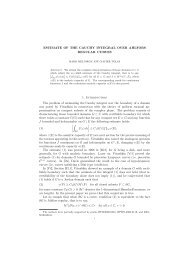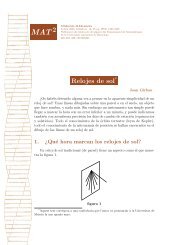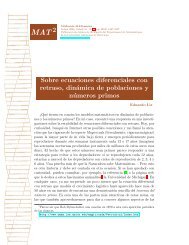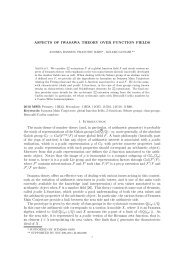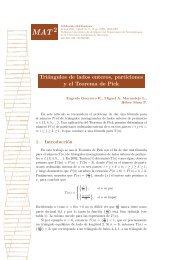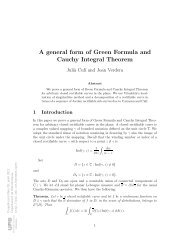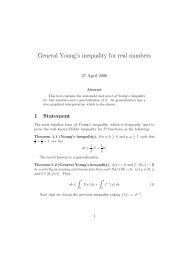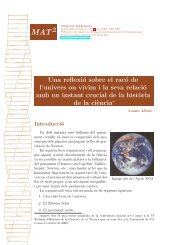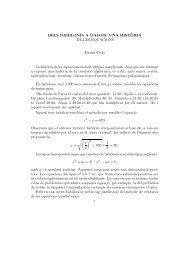classifying spaces for proper actions of locally finite groups
classifying spaces for proper actions of locally finite groups
classifying spaces for proper actions of locally finite groups
You also want an ePaper? Increase the reach of your titles
YUMPU automatically turns print PDFs into web optimized ePapers that Google loves.
CLASSIFYING SPACES FOR PROPER<br />
ACTIONS OF LOCALLY FINITE GROUPS<br />
Warren Dicks, Peter H. Kropholler, Ian J. Leary and Simon Thomas<br />
April 16, 2002<br />
For each <strong>finite</strong> ordinal n, and each <strong>locally</strong> <strong>finite</strong> group G <strong>of</strong> cardinality ℵ n ,weconstruct<br />
an (n + 1)-dimensional, contractible CW-complex on which G acts with <strong>finite</strong><br />
stabilizers. We use the complex to obtain in<strong>for</strong>mation about cohomology with induced<br />
coefficients. Our techniques also give in<strong>for</strong>mation about the location <strong>of</strong> some<br />
large free abelian <strong>groups</strong> in the hierarchy H .<br />
Throughout, let G be a group, and let A be a Z-module with trivial G-action.<br />
We let AG denote the induced ZG-module ZG ⊗ Z A. Ring-<strong>actions</strong> on modules<br />
and group-<strong>actions</strong> on sets are tacitly understood to be on the left, if not specified<br />
otherwise.<br />
1. Holt’s Conjectures<br />
The purpose <strong>of</strong> this section is to describe our main algebraic results, Theorems<br />
3.10 and 5.4, and place them in the context <strong>of</strong> prior work.<br />
1.1 Notation. Let rank(G) denote the smallest cardinal κ such that there exists<br />
some set <strong>of</strong> generators <strong>of</strong> G <strong>of</strong> cardinality κ.<br />
If G is not <strong>finite</strong>ly generated, then rank(G) =|G|, and we define ℵ-rank(G) tobe<br />
the ordinal α such that rank(G) =ℵ α ;ifG is <strong>finite</strong>ly generated, then rank(G) < |G|,<br />
and we set ℵ-rank(G) =−1.<br />
Recall that, <strong>for</strong> each ordinal α, ω α denotes the least ordinal <strong>of</strong> cardinality ℵ α .<br />
We find it convenient to set ℵ −1 =1.<br />
Throughout this section, let n ∈ N (= ω 0 ). □<br />
D. F. Holt proposed the following description <strong>of</strong> the cohomology with induced<br />
coefficients, <strong>for</strong> <strong>locally</strong> <strong>finite</strong> <strong>groups</strong>.<br />
1.2 Conjecture (Holt [6]). If G is <strong>locally</strong> <strong>finite</strong>, then<br />
| H n (G, AG)| = |A| ℵ n−1<br />
if n = ℵ-rank(G)+1,<br />
H n (G, AG) =0 if n ≠ ℵ-rank(G)+1.<br />
Commentary. In Examples 3.3 we recall that, <strong>for</strong> any group G,<br />
{ A if G is <strong>finite</strong> and n =0,<br />
(1.3) H n (G, AG) =<br />
0 if G is <strong>finite</strong> or n = 0, but not both.<br />
1991 Mathematics Subject Classification. Primary 20F50; Secondary 20J06, 20K20, 57M07.<br />
1
2 DICKS, KROPHOLLER, LEARY AND THOMAS<br />
Thus the conjecture really concerns the cases where n ≥ 1andG is in<strong>finite</strong>, and<br />
the notation has been artificially contrived to embrace the trivial marginal cases.<br />
For any in<strong>finite</strong> group G, theset<strong>of</strong>cocycles<strong>for</strong>G with coefficients in AG is <strong>of</strong><br />
cardinality |A| |G| ,so1≤|H n (G, AG)| ≤|A| |G| . If G is in<strong>finite</strong> and <strong>locally</strong> <strong>finite</strong>,<br />
then the conjecture implies that only the extreme values can be achieved. □<br />
We now briefly state the cases which are known, including those obtained in this<br />
paper.<br />
1.4 Notation. We say that G has the <strong>finite</strong> extension <strong>proper</strong>ty <strong>for</strong> <strong>proper</strong> sub<strong>groups</strong><br />
if each <strong>proper</strong> subgroup <strong>of</strong> G is a <strong>proper</strong> subgroup <strong>of</strong> <strong>finite</strong> index in some subgroup<br />
<strong>of</strong> G. For example, abelian torsion <strong>groups</strong> have this <strong>proper</strong>ty.<br />
Let us say that A is o(G)-inverting if, <strong>for</strong> every <strong>finite</strong> subgroup H <strong>of</strong> G, multiplication<br />
by |H| gives an automorphism <strong>of</strong> A; equivalently, <strong>for</strong> each g ∈ G whose<br />
order o(g) is <strong>finite</strong>, multiplication by o(g) gives an automorphism <strong>of</strong> A.<br />
If R is a ring (associative, with 1), then R is o(G)-inverting, as Z-module, if and<br />
only if the order <strong>of</strong> each <strong>finite</strong> subgroup <strong>of</strong> G is a unit in R. If R is not o(G)-inverting,<br />
then it is easy to show that cd R G, the cohomological dimension <strong>of</strong> G with<br />
respect to R, is∞, a value which we shall think <strong>of</strong> as ω 0 = ℵ 0 . □<br />
1.5 Known cases <strong>of</strong> Conjecture 1.2. Let G be a <strong>locally</strong> <strong>finite</strong> group.<br />
(1) H n (G, AG) =0if n>ℵ-rank(G)+1.<br />
(2) If G has the <strong>finite</strong> extension <strong>proper</strong>ty <strong>for</strong> <strong>proper</strong> sub<strong>groups</strong>, then<br />
H n (G, AG) =0if n ≠ ℵ-rank(G)+1.<br />
(3) For n ∈{0, 1}, H n (G, AG) =0if n ≠ ℵ-rank(G)+1.<br />
(4) For n ∈{0, 1, 2}, | H n (G, AG)| = |A| ℵ n−1<br />
if n = ℵ-rank(G)+1.<br />
(5) It is consistent with ZFC that<br />
| H n (G, AG)| ≥2 ℵ n−1<br />
if n = ℵ-rank(G)+1 and A is nonzero.<br />
Hence, it is consistent with ZFC that<br />
| H n (G, AG)| = |A| ℵ n−1<br />
if n = ℵ-rank(G)+1 and |A| ≤ℵ n−1 .<br />
Commentary. (1), the “easy” part <strong>of</strong> Conjecture 1.2, is proved in Theorem 3.10. It<br />
was proved in [11] <strong>for</strong> the case where A is o(G)-inverting, and, be<strong>for</strong>e that, in [4], [5]<br />
<strong>for</strong> the case where A is o(G)-inverting and torsion.<br />
(2) was proved by Holt [5]. We give another pro<strong>of</strong> <strong>of</strong> the abelian case in Corollary<br />
6.10.<br />
(3). By (1.3), this holds <strong>for</strong> n = 0. It was proved by Holt [6] <strong>for</strong> n = 1;<br />
see Theorem 6.4.<br />
(4). By (1.3), this holds <strong>for</strong> n =0. Itiswellknown<strong>for</strong>n = 1; see Theorem 4.5.<br />
In Theorem 5.4, we prove it <strong>for</strong> n = 2; Holt [6] had previously shown this was<br />
consistent with ZFC, see [14, Section 1].<br />
(5). Suppose that n = ℵ-rank(G)+1andthatA is nonzero.<br />
We shall now see that it is consistent with ZFC that | H n (G, AG)| ≥2 ℵ n−1<br />
.<br />
For each prime p, wewriteZ(p ∞ ) :=<br />
lim<br />
m→∞ Z/pm Z,where,<strong>for</strong>m ∈ N, themap<br />
Z/p m Z → Z/p m+1 Z is given by multiplication by p.<br />
We claim that there exists a Z-module k, andaZ-submodule A ′ <strong>of</strong> A, such that<br />
the quotient A/A ′ is isomorphic to k, and either k = Q, or there exists a prime p<br />
such that k = Z/pZ or k = Z(p ∞ ).
CLASSIFYING SPACES FOR PROPER ACTIONS OF LOCALLY FINITE GROUPS 3<br />
Consider first the case where A is not divisible, so there exists a prime p such<br />
that A/pA is nonzero. But A/pA is a direct sum <strong>of</strong> Z-submodules each <strong>of</strong> which is<br />
isomorphic to Z/pZ. Hence A/pA projects onto any such summand.<br />
If A is divisible, then A is a direct sum <strong>of</strong> Z-submodules each <strong>of</strong> which is isomorphic<br />
to Q or to Z(p ∞ )<strong>for</strong>someprimep; see, <strong>for</strong> example, [3, Theorem IV.23.1].<br />
Hence A projects onto any such summand.<br />
In all cases, we can find A ′ , k as claimed.<br />
Now there is a long exact sequence in cohomology which contains the subsequence<br />
H n (G, AG) → H n (G, kG) → H n+1 (G, A ′ G).<br />
By (1), H n+1 (G, A ′ G)=0,so| H n (G, AG)| ≥|H n (G, kG)|.<br />
Thus, <strong>for</strong> the first part, it remains to show that it is consistent with ZFC that<br />
| H n (G, kG)| ≥2 ℵ n−1<br />
.<br />
It is proved in [11] that, if k is an o(G)-inverting prime field, then it is consistent<br />
with ZFC that | H n (G, kG)| ≥2 ℵ n−1<br />
. However on carefully reading that pro<strong>of</strong>,<br />
one sees that all applications <strong>of</strong> the o(G)-inverting hypothesis can be replaced with<br />
applications <strong>of</strong> (1), so, in fact, it is proved that it is consistent with ZFC that if k<br />
is a prime field then | H n (G, kG)| ≥2 ℵ n−1<br />
.<br />
It remains to consider the case where k = Z(p ∞ )<strong>for</strong>someprimep. Again,<br />
it is not difficult to show that the argument in [11] can be further modified to<br />
cover this case by interpreting dim k m := m <strong>for</strong> all m ∈ N. If M is a <strong>finite</strong>ly<br />
generated (free) Z-submodule <strong>of</strong> ZG, andkM denotes the image <strong>of</strong> the natural<br />
map k ⊗ Z M → k ⊗ Z ZG = kG, then one can show dim kM =rankM, sincek is<br />
divisible. Moreover, if M ′ is a Z-submodule <strong>of</strong> M, thendimkM ′ ≤ dim kM, and,<br />
if equality holds, then kM ′ = kM, sincek is divisible. Using these observations,<br />
one can verify that the argument in [11] applies with k = Z(p ∞ ).<br />
It follows that, in all cases, it is consistent with ZFC that | H n (G, kG)| ≥2 ℵ n−1<br />
.<br />
Now suppose that |A| ≤ℵ n−1 . Hence |A| ℵ n−1<br />
=2 ℵ n−1<br />
; see [7, p.49] <strong>for</strong> the case<br />
where n ≥ 1. Thus, it is consistent with ZFC that | H n (G, AG)| ≥|A| ℵ n−1<br />
.<br />
We previously observed that | H n (G, AG)| ≤|A| ℵ n−1<br />
, so it is consistent with<br />
ZFC that | H n (G, AG)| = |A| ℵ n−1<br />
.<br />
This proves (5). It had previously been proved by Holt [5] in the case where G<br />
has the <strong>finite</strong> extension <strong>proper</strong>ty <strong>for</strong> <strong>proper</strong> sub<strong>groups</strong>; see [14, Section 1]. □<br />
We wish to refine part <strong>of</strong> Conjecture 1.2.<br />
1.6 Conjecture. If G is <strong>locally</strong> <strong>finite</strong>, and n = ℵ-rank(G) +1,thenH n (G, AG)<br />
contains a Z-submodule isomorphic to A ℵ n−1<br />
, and hence | H n (G, AG)| = |A| ℵ n−1<br />
.<br />
Commentary. By (1.3), this holds <strong>for</strong> n = 0. It is probably well known <strong>for</strong> n =1;<br />
see Theorem 4.5. In Theorem 5.4, we prove it <strong>for</strong> n =2. □<br />
Conjecture 1.2 was preceded by, and motivated by, an earlier proposal, concerning<br />
the cohomological dimension <strong>of</strong> <strong>locally</strong> <strong>finite</strong> <strong>groups</strong>.
4 DICKS, KROPHOLLER, LEARY AND THOMAS<br />
1.7 Conjecture. If G is a <strong>locally</strong> <strong>finite</strong> group, and R is a nonzero, o(G)-inverting<br />
ring, then cd R G =min{ℵ-rank(G)+1, ∞}.<br />
Commentary. Holt [4] proposed this conjecture with the additional hypothesis that<br />
R is a field <strong>of</strong> prime order, and, in [11], the additional hypothesis was weakened to<br />
R being commutative.<br />
Notice that min{ℵ-rank(G)+1, ∞} can be expressed as inf{n ∈ N |ℵ n > |G|},<br />
where the infimum <strong>of</strong> the empty set is taken to be ∞.<br />
The inequality cd R G ≤ℵ-rank(G) + 1 follows from a classic result <strong>of</strong> Auslander<br />
[1, Proposition 3]; see [12, Lemma 3.7] or Theorem 3.10 below.<br />
Cohomological dimension cannot increase on passing to a subgroup, so we may<br />
assume that ℵ-rank(G)
CLASSIFYING SPACES FOR PROPER ACTIONS OF LOCALLY FINITE GROUPS 5<br />
We let F denote the class <strong>of</strong> <strong>finite</strong> <strong>groups</strong>. Notice that F ∩ sub(G) is a subgroup-closed<br />
G-family. A space <strong>of</strong> type E(G, F) is called an EG. (It is also called a<br />
<strong>classifying</strong> space <strong>for</strong> <strong>proper</strong> G-<strong>actions</strong>, that is, G-<strong>actions</strong> with <strong>finite</strong> stabilizers.) □<br />
The following is well known.<br />
2.2 Proposition. If X is a subgroup-closed G-family, then there exists a space <strong>of</strong><br />
type E(G, X), andanyG-map between two <strong>spaces</strong> <strong>of</strong> type E(G, X) is a G-homotopy<br />
equivalence.<br />
Pro<strong>of</strong>. The first part can be seen by Milnor’s construction. Thus, let ∆ be any<br />
G-set such that X is precisely the set <strong>of</strong> sub<strong>groups</strong> <strong>of</strong> G which fix at least one point<br />
<strong>of</strong> ∆. Let X =∆∗ ∆ ∗ ∆ ∗···, the union <strong>of</strong> iterated joins <strong>of</strong> ∆. Then X is a space<br />
<strong>of</strong> type E(G, X).<br />
For the second part, see, <strong>for</strong> example, [15, Proposition II.2.7]. □<br />
2.3 Corollary. If X 1 ⊆ X 2 are subgroup-closed G-families, and X 1 (resp. X 2 )<br />
is a space <strong>of</strong> type E(G, X 1 )(resp. E(G, X 2 )), then there exists a cellular G-map<br />
X 1 → X 2 .<br />
Pro<strong>of</strong>. The join X 1 ∗ X 2 is a space <strong>of</strong> type E(G, X 2 ), and the inclusions<br />
ι 1 : X 1 → X 1 ∗ X 2 , ι 2 : X 2 → X 1 ∗ X 2<br />
are G-maps. By Proposition 2.2, ι 2 is a G-homotopy equivalence, and the homotopy<br />
inverse X 1 ∗ X 2 → X 2 composed with ι 1 gives a G-map X 1 → X 2 . This<br />
is then G-homotopic to a cellular G-map X 1 → X 2 ; see, <strong>for</strong> example, [15, Theorem<br />
II.2.1]. □<br />
One could give a dual pro<strong>of</strong>, using the projection maps from the Cartesian product<br />
X 1 × X 2 , which is a space <strong>of</strong> type E(G, X 1 ).<br />
The following is a topological analogue <strong>of</strong> a classic result <strong>of</strong> Auslander [1, Proposition<br />
3].<br />
2.4 Theorem. Let β be a limit ordinal, let (G α | α ≤ β) be a continuous chain <strong>of</strong><br />
sub<strong>groups</strong> <strong>of</strong> G, andlet(X α | α ≤ β) be a continuous chain <strong>of</strong> subsets <strong>of</strong> sub(G)<br />
such that, <strong>for</strong> each α ≤ β, X α is a subgroup-closed G α -family.<br />
Let n ∈ N, and suppose that, <strong>for</strong> each α
6 DICKS, KROPHOLLER, LEARY AND THOMAS<br />
By Proposition 2.2, since X α and Y α are <strong>of</strong> type E(G α , X α ) there exists a cellular<br />
G α -map Y α → X α , and hence a cellular G α+1 -map G α+1 × Gα Y α → G α+1 × Gα X α .<br />
Take X α+1 to be the identification space, or pushout,<br />
G α+1 × Gα Y α −−−−→ M α<br />
⏐<br />
⏐<br />
↓<br />
↓<br />
G α+1 × Gα X α −−−−→ X α+1 .<br />
Notice that dim X α+1 = n +1, since dimY α = n, dimM α = n +1, and<br />
dim X α ≤ n + 1. It is not difficult to check that X α+1 is <strong>of</strong> type E(G α+1 , X α+1 ).<br />
This completes the pro<strong>of</strong>. □<br />
2.5 Remark. For n =0andβ = ω 0 , the construction in the above pro<strong>of</strong> gives the<br />
Bass-Serre tree <strong>of</strong> the graph <strong>of</strong> <strong>groups</strong> corresponding to the countable ascending<br />
chain (G α | α
CLASSIFYING SPACES FOR PROPER ACTIONS OF LOCALLY FINITE GROUPS 7<br />
2.8 Theorem. If n ∈ N, andℵ-rank(G)
8 DICKS, KROPHOLLER, LEARY AND THOMAS<br />
3.3 Examples. Let G be a <strong>finite</strong> group.<br />
Here, AG = A[[G]], so induced ZG-modules are co-induced, and hence G-acyclic.<br />
Suppose that M is an o(G)-inverting ZG-module. Then the multiplication map<br />
M[[G]] → M,<br />
∑<br />
g∈G<br />
m g .g ↦→ ∑ g∈G<br />
gm g ,<br />
is ZG-split with right inverse m ↦→ 1 ∑<br />
g −1 m.g. Here, M is a ZG-summand <strong>of</strong><br />
|G|<br />
g∈G<br />
an induced ZG-module, so M is G-acyclic. □<br />
In the following, G acts on tensor products over Z via the diagonal action.<br />
3.4 Lemma. Let M be a ZG-module.<br />
(1) The functor Hom ZG (−⊗ Z ZG, M) carries Z-split exact sequences <strong>of</strong> ZG-modules<br />
to exact sequences.<br />
(2) Let H be a subgroup <strong>of</strong> G. IfM is H-acyclic, then the functor<br />
Hom ZG (Z[G/H] ⊗ Z −,M)<br />
carries augmented ZG-projective resolutions <strong>of</strong> Z to exact sequences.<br />
Pro<strong>of</strong>. (2). Let L be a ZG-module. There is a natural identification <strong>of</strong> ZG-modules,<br />
with gH ⊗ l corresponding to g ⊗ g −1 l.<br />
It follows that we can identify<br />
Z[G/H] ⊗ Z L = ZG ⊗ ZH L,<br />
Hom ZG (Z[G/H] ⊗ Z −,M)=Hom ZG (ZG ⊗ ZH −,M)=Hom ZH (−,M)<br />
as functors on ZG-modules. Since M is H-acyclic, this functor carries augmented<br />
ZG-projective resolutions <strong>of</strong> Z to exact sequences.<br />
(1) is proved similarly. □<br />
3.5 Notation. Let X be a G-complex.<br />
We shall treat X as the G-set whose elements are the open cells <strong>of</strong> X. The cellular<br />
chain complex <strong>of</strong> X is then the permutation module ZX, with the structure <strong>of</strong> a<br />
differential graded ZG-module, with differential ∂ <strong>of</strong> degree −1. Here the grading<br />
is that determined by the dimensions <strong>of</strong> the cells, so the nth component C n (ZX)<br />
has as Z-basis the cells <strong>of</strong> dimension n.<br />
We let η: X × X → Z denote the function such that ∂x = ∑ η(x, y).y <strong>for</strong> each<br />
x ∈ X. Thus,ifx is an n-cell, then η(x, y) = 0 unless y is one <strong>of</strong> the <strong>finite</strong>ly many<br />
(n − 1)-cells incident to x. □<br />
The following is a degenerate case <strong>of</strong> the equivariant cohomology spectral sequence;<br />
see, <strong>for</strong> example, [2, VII.7.10(7.10)].<br />
y∈X
CLASSIFYING SPACES FOR PROPER ACTIONS OF LOCALLY FINITE GROUPS 9<br />
3.6 Theorem. Let X be an acyclic G-complex. If M is a ZG-module which is<br />
G x -acyclic <strong>for</strong> each x ∈ X, then H ∗ (Hom ZG (ZX, M)) ≃ H ∗ (G, M), as graded<br />
abelian <strong>groups</strong>.<br />
Recall that Hom ZG (ZX, M) denotes the differential graded abelian group with<br />
nth component C n (Hom ZG (ZX, M)) = Hom ZG (C n (ZX),M).<br />
Pro<strong>of</strong>. The homology <strong>of</strong> (ZX, ∂) isZ, concentrated in degree zero.<br />
We choose a free ZG-resolution <strong>of</strong> Z, andwriteitas(ZY,∂) <strong>for</strong>someG-free<br />
G-set Y ; <strong>for</strong> example, we could take Y to be an E G, andZY its cellular chain<br />
complex. Then Hom ZG (ZY,M) is an additive abelian differential graded group,<br />
and its cohomology is H ∗ (G, M).<br />
We consider the double complex ZX ⊗ Z ZY with diagonal G-action, and the<br />
double complex Hom ZG (ZX ⊗ Z ZY,M). We get a fourth-quadrant commuting<br />
diagram which can be schematically represented as<br />
0<br />
⏐<br />
↓<br />
(3.7)<br />
Hom ZG (ZX, M)<br />
⏐<br />
↓<br />
0 −−−−→ Hom ZG (ZY,M) −−−−→ Hom ZG (ZX ⊗ Z ZY,M).<br />
To show that the cohomology group <strong>of</strong> the outer row, Hom ZG (ZX, M), is isomorphic<br />
to the cohomology group <strong>of</strong> the outer column, Hom ZG (ZY,M), it suffices<br />
to show that the remaining, or inner, rows and columns <strong>of</strong> (3.7) are exact. Each<br />
inner column is exact because Hom ZG (ZX ⊗ Z −,M) is exact on augmented projective<br />
ZG-resolutions <strong>of</strong> Z, by Lemma 3.4(2). Similarly, each inner row is exact<br />
because Hom ZG (−⊗ Z ZY,M) isexactonZ-split exact sequences <strong>of</strong> ZG-modules,<br />
by Lemma 3.4(1). □<br />
3.8 Corollary. Let M be a ZG-module, and let X be a <strong>finite</strong>-dimensional acyclic<br />
G-complex. If M is G x -acyclic <strong>for</strong> each x ∈ X, then H n (G, M) = 0 <strong>for</strong> all<br />
n>dim X. □<br />
We record the case <strong>of</strong> <strong>finite</strong> stabilizers.<br />
3.9 Corollary. Let M be a ZG-module, and suppose that M is H-acyclic <strong>for</strong><br />
each <strong>finite</strong> subgroup H <strong>of</strong> G; <strong>for</strong> example, this holds if M = AG, or if M is<br />
o(G)-inverting. Let X be an acyclic G-complex with <strong>finite</strong> stabilizers; <strong>for</strong> example,<br />
this holds if X is an EG. ThenH n (G, M) =0<strong>for</strong> all n>dim X. □<br />
Here we can apply Theorem 2.6.<br />
3.10 Theorem. Let G be a <strong>locally</strong> <strong>finite</strong> group, and M a ZG-module which is<br />
H-acyclic <strong>for</strong> each <strong>finite</strong> subgroup H <strong>of</strong> G; <strong>for</strong> example, this holds if M = AG, or<br />
if M is o(G)-inverting. Then H n (G, M) =0<strong>for</strong> all n>ℵ-rank(G)+1. □<br />
3.11 Remark. Theorem 3.10 can also be proved using the argument <strong>of</strong> the first<br />
paragraph <strong>of</strong> [11, Section 1]. □
10 DICKS, KROPHOLLER, LEARY AND THOMAS<br />
4. Locally <strong>finite</strong> <strong>groups</strong> <strong>of</strong> cardinality ℵ 0<br />
In this section, we recall how H ∗ (G, AG) can be computed using an EG, and<br />
apply the method in the one-dimensional case.<br />
4.1 Definitions. Let X be an EG, or, more generally, any acyclic G-complex in<br />
which all cell stabilizers are <strong>finite</strong>, and let Notation 3.5 apply.<br />
We have natural identifications<br />
(4.2) A[[X]] = A X =Hom Z (ZX, A).<br />
For simplicity, let us suppose that X is <strong>finite</strong> dimensional.<br />
Then A[[X]] has the structure <strong>of</strong> a differential graded ZG-module, in which the<br />
differential ∂ ∗ has degree +1, and is given by<br />
∂ ∗ ( ∑ a x .x) = ∑ ( ∑ η(x, y)a y ).x.<br />
x∈X<br />
x∈X y∈X<br />
The cohomology <strong>of</strong> (A[[X]],∂ ∗ )isA concentrated in degree zero.<br />
Let<br />
A G [[X]] := { ∑ x∈X<br />
a x .x ∈ A[[X]] |{g ∈ G | a gx ≠0} is <strong>finite</strong>, <strong>for</strong> all x ∈ X}.<br />
Since G-stabilizers are <strong>finite</strong>, we see that A G [[X]] consists <strong>of</strong> all functions from<br />
X to A with <strong>finite</strong> support in each G-orbit.<br />
It is straight<strong>for</strong>ward to check that A G [[X]] is a differential graded ZG-submodule<br />
<strong>of</strong> A[[X]].<br />
We write C n (A G [[X]]), B n (A G [[X]]), and Z n (A G [[X]]) <strong>for</strong> the n-cochains, n-coboundaries,<br />
and n-cocycles, respectively. □<br />
Sometimes the notation Hom c (Z[X],A)isusedtodenoteA G [[X]]; see, <strong>for</strong> example,<br />
[2, Lemma VIII.7.4].<br />
The following is a variation on the usual “compact supports” cohomology; see,<br />
<strong>for</strong> example, [2, Proposition VIII.7.5]. It is particularly useful in the study <strong>of</strong> ends<br />
<strong>of</strong> <strong>groups</strong>.<br />
4.3 Theorem. If X is a <strong>finite</strong>-dimensional acyclic G-complex with <strong>finite</strong> stabilizers,<br />
then there is a natural isomorphism H ∗ (A G [[X]]) ≃ H ∗ (G, AG) <strong>of</strong> graded<br />
abelian <strong>groups</strong>.<br />
Pro<strong>of</strong>. There is a natural identification <strong>of</strong> Hom ZG (ZX, A[[G]]) with Hom Z (ZX, A);<br />
see (3.2). There is also a natural identification <strong>of</strong> Hom Z (ZX, A) with A[[X]];<br />
see (4.2). It is easy to show that under these identifications, Hom ZG (ZX, AG)<br />
corresponds to A G [[X]]. Hence H ∗ (A G [[X]]) ≃ H ∗ (Hom ZG (ZX, AG)). Finally,<br />
H ∗ (Hom ZG (ZX, AG)) ≃ H ∗ (G, AG), by Theorem 3.6. □<br />
There is a natural right G-action on H ∗ (G, AG), arising from the ZG-bimodule<br />
structure on AG. This agrees with the natural right G-action on A G [[X]] which we<br />
have trans<strong>for</strong>med into a left G-action.<br />
Let us illustrate how Theorem 4.3 can be used to study H ∗ (G, AG) whenG is<br />
<strong>locally</strong> <strong>finite</strong> <strong>of</strong> cardinality ℵ 0 . To do this we now construct a standardized EG, as<br />
in Remark 2.5.
CLASSIFYING SPACES FOR PROPER ACTIONS OF LOCALLY FINITE GROUPS 11<br />
4.4 Definition. Let G be a <strong>locally</strong> <strong>finite</strong> group <strong>of</strong> cardinality ℵ 0 .<br />
Index the elements <strong>of</strong> G with ω 0 ,soG = {h α | α
12 DICKS, KROPHOLLER, LEARY AND THOMAS<br />
Hence φ(p) = 0, which is a contradiction.<br />
This proves that the composition<br />
A P → A[[Q]] → H 1 (A G [[X]]) = H 1 (G, AG)<br />
is injective. Since |P| = ℵ 0 , A ℵ 0<br />
embeds in H 1 (G, AG). □<br />
5. Locally <strong>finite</strong> <strong>groups</strong> <strong>of</strong> cardinality ℵ 1<br />
In this section we study H ∗ (G, AG) whenG is <strong>locally</strong> <strong>finite</strong> with ℵ-rank(G) =1,<br />
topologizing and refining results <strong>of</strong> D. F. Holt.<br />
We begin by constructing a standardized EG.<br />
5.1 Definitions. Let G be a <strong>locally</strong> <strong>finite</strong> group <strong>of</strong> cardinality ℵ 1 .<br />
Let ω 1 ′ denote the set <strong>of</strong> limit ordinals less than ω 1.<br />
As in Definition 4.4, we start by indexing the elements <strong>of</strong> G, G = {h α | α
CLASSIFYING SPACES FOR PROPER ACTIONS OF LOCALLY FINITE GROUPS 13<br />
For α
14 DICKS, KROPHOLLER, LEARY AND THOMAS<br />
Let Y be the subgraph <strong>of</strong> X obtained by deleting the vertices H and K and all<br />
their incident edges. It suffices to show that Y is a connected graph. Since X is<br />
connected, it suffices to show that each X-neighbour <strong>of</strong> H is Y -connected to each<br />
X-neighbour <strong>of</strong> K. Thus,leth ∈ H − K, andk ∈ K − H; it suffices to show that<br />
the vertices hK and kH are Y -connected.<br />
Let L = 〈hk −1 〉 = 〈kh −1 〉.SinceG is periodic, L is <strong>finite</strong>.<br />
We consider the action <strong>of</strong> L on X. Letm and n denote the orders <strong>of</strong> the L-orbits<br />
<strong>of</strong> the vertices H and K, respectively. By symmetry, we may assume that m ≥ n.<br />
Notice that L is not contained in K, son ≥ 2.<br />
Let g = kh −1 . In X, there is an edge H ∩ K joining H to K, and an edge<br />
k(H ∩ K) joining kH = gH to kK = K. Applying powers <strong>of</strong> g to these, we get a<br />
path in X with vertices<br />
H, K, gH, gK, g 2 H, g 2 K,... ,g n−1 H, g n−1 K.<br />
By the definition <strong>of</strong> m and n, these2n vertices are all distinct, so, on deleting the<br />
first two, we get a path in Y connecting gH = kH to g n−1 K = g −1 K = hK. □<br />
5.3 Theorem (Holt [6]). If G is <strong>locally</strong> <strong>finite</strong>, and |G| = ℵ 1 ,thenH 1 (G, AG) =0.<br />
Pro<strong>of</strong>. Let X be as in Definitions 5.1.<br />
Consider any φ ∈ Z 1 (A G [[X]]). Thus supp(φ) is a collection <strong>of</strong> edges <strong>of</strong> X,<br />
with only <strong>finite</strong>ly many in each G-orbit. A subset <strong>of</strong> X which meets (that is,<br />
has nonempty intersection with) supp(φ) issaidtobebroken by φ. Since φ is a<br />
1-cocycle, we get 0 if we sum, in A, theφ-labels, with the appropriate signs, around<br />
any face, or along any closed path in the 1-skeleton, since X is simply connected.<br />
Thus there is a well-defined φ-sum from any vertex to any other vertex.<br />
Consider any α ∈ ω 1 ′ such that φ respects α as in the last paragraph <strong>of</strong> Definitions<br />
5.1.<br />
From Definitions 5.1, there is a cellular G α+1 -map M α → X, soφ induces an<br />
element φ α+1 ∈ A[[M α ]]. Since the G-stabilizers <strong>for</strong> X are <strong>finite</strong>, φ α+1 lies in<br />
A Gα+1 [[M α ]], Moreover, φ α+1 respects α in the obvious sense, since Y α is mapped<br />
to X α ,byconstruction.<br />
There exists n 0
CLASSIFYING SPACES FOR PROPER ACTIONS OF LOCALLY FINITE GROUPS 15<br />
H − ∩ K − . It follows that deleting g −1 K − p n from Y leaves a connected space<br />
containing G α+1,n0 v 1,0 .<br />
Suppose g ∉ G α+1,n0 ,sog ∈ G α+1,n −G α+1,n0 . Then supp(φ α+1 )∩gY ⊆ K − p n .<br />
Hence, on deleting supp(φ α+1 ) from the 1-skeleton <strong>of</strong> M α , one <strong>of</strong> the resulting<br />
components contains gG α+1,n0 v 1,0 .<br />
Next, we apply Lemma 5.2 to the graph Z ′ obtained by taking H = G α+1,n0<br />
and K = G α,n ,so〈H, K〉 = G α+1,n . We conclude that<br />
Z ′ − ({H}∪{K}∪(H ∪ K)/(H ∩ K))<br />
is a connected graph.<br />
Let Z be the G α+1,n -subspace <strong>of</strong> M α generated by e · p n , and consider the map<br />
<strong>of</strong> G α+1,n -<strong>spaces</strong> from Z to Z ′ which assigns v 1,0 to H, v 0,n to K, ande · p n to<br />
H ∩ K. There is induced a surjective map<br />
Z − ({v 1,0 }∪{v 0,n }∪(H ∪ K)(e · p n )) → Z ′ − ({H}∪{K}∪(H ∪ K)/(H ∩ K)).<br />
Notice that φ α+1 breaks only edges <strong>of</strong> Z which lie in He ∪ Kp n ,sothereisa<br />
map from Z − ({v 1,0 }∪{v 0,n }∪(H ∪ K)(e · p n )) to the set <strong>of</strong> components <strong>of</strong> the<br />
1-skeleton <strong>of</strong> M α − supp(φ α+1 ). Moreover, we have seen that each subset gHv 1,0<br />
maps to a component <strong>of</strong> the 1-skeleton <strong>of</strong> M α − supp(φ α+1 ). Thus the map factors<br />
through Z ′ − ({H}∪{K}∪(H ∪ K)/(H ∩ K)), which is connected, so maps to a<br />
single component. Hence some component X ′ <strong>of</strong> the 1-skeleton <strong>of</strong> M α −supp(φ α+1 )<br />
contains (〈H, K〉−H)v 1,0 ,thatis,(G α+1,n − G α+1,n0 )v 1,0 .<br />
Since n>n 0 was arbitrary, all <strong>of</strong> (G α+1 −G α+1,n0 )v 1,0 is contained in X ′ .Thus,<br />
<strong>for</strong> any path between any two elements <strong>of</strong> (G α+1 −G α+1,n0 )v 1,0 ,theφ α+1 -sum, and<br />
hence the φ-sum, is 0.<br />
Let ψ α+1 ∈ C 0 (A[[X α+1 ]]) be defined on each vertex v as the φ-sum along any<br />
path from any vertex <strong>of</strong> (G α+1 −G α+1,n0 )v 1,0 to v. Thenψ α+1 ∈ C 0 (A Gα+1 [[X α+1 ]])<br />
and φ| Xα+1 = ∂ ∗ (ψ α+1 ).<br />
The α
16 DICKS, KROPHOLLER, LEARY AND THOMAS<br />
We have a cellular G α -map Y α → X α , and, similarly, by Corollary 2.3, we can<br />
construct a cellular G 0 -map Y α • → Y 0 between <strong>spaces</strong> <strong>of</strong> type EG 0 .Thesetwomaps<br />
can be extended to a G α -map M α ′ → X α.<br />
Notice that Y α is contained in both M α and M α,andthemapY ′ α → X α has<br />
been extended to M α → X α+1 and to M α ′ → X α.<br />
For each n
CLASSIFYING SPACES FOR PROPER ACTIONS OF LOCALLY FINITE GROUPS 17<br />
Hence<br />
∂(h α,n (1 − g)<br />
n∑<br />
f −1,i )=h α,n (1 − g)(x −1,0 +<br />
i=0<br />
n∑<br />
(y 0,i − y −1,i )).<br />
We can view ψ α as an additive map Z[EM α ] → A, and apply it to the <strong>for</strong>egoing<br />
equation, to get<br />
φ α (h α,n (1 − g)<br />
n∑<br />
f −1,i )<br />
i=0<br />
=ψ α (h α,n (1 − g)(x −1,0 +<br />
i=0<br />
n∑<br />
(y 0,i − y −1,i ))).<br />
Notice that h α,n G λα,n ∩ G λα,n = ∅.<br />
Since h α,n ,h α,n g ∉ G λ<br />
′<br />
α,i<br />
,<strong>for</strong>0≤ i ≤ n, weseeφ α (h α,n (1 − g) n ∑<br />
Also, h α,n ,h α,n g/∈ G µ ,soψ α (h α,n (1 − g)y −1,i )=0.<br />
Also, h α,n ,h α,n g/∈ G κ ,soψ α (h α,n (1 − g)x −1,0 )=0.<br />
∑<br />
It follows that ψ α (h α,n (1 − g) n y 0,i )=0.<br />
i=0<br />
∑<br />
But h α,n ,h α,n g/∈ G ν ,so(ψ α − ξ)(h α,n (1 − g) n y 0,i )=0. Hence<br />
ξ(<br />
i=0<br />
i=0<br />
n∑<br />
h α,n (1 − g)y 0,i )=0.<br />
i=0<br />
i=0<br />
f −1,i )=0.<br />
Now ξ(h α,n y 0,n ) = −φ(p), and ξ vanishes on all other summands because<br />
h α,n G 0 ∩ G λα,i +1 = ∅ <strong>for</strong> 0 ≤ i ≤ n − 1, and gy 0,n ≠ y 0,n . Hence φ(p) =0,<br />
which is a contradiction.<br />
Since |P| = ℵ 1 , we have an embedding <strong>of</strong> A ℵ 1<br />
in H 2 (G, AG). □<br />
6. Cohomology <strong>of</strong> directed unions<br />
In this section, we recall some known results about cohomology <strong>for</strong> well-ordered<br />
directed unions, with special emphasis on abelian <strong>groups</strong>.<br />
6.1 Notation. We let (P(G),∂) denote the bar resolution <strong>for</strong> G, andletP n (G)<br />
denote its nth component, <strong>for</strong> each n ∈ Z. Thus(P(G),∂)isafreeZG-resolution <strong>of</strong><br />
Z, and, <strong>for</strong> n ≥ 0, P n (G) has as Z-basis the Cartesian power G n+1 ,withG acting<br />
by left multiplication on the first coordinate, and, <strong>for</strong> n ≥ 1,<br />
∂ n (g 0 ,... ,g n ):=<br />
n−1<br />
∑<br />
(−1) i (g 0 ,... ,g i−1 ,g i g i+1 ,g i+2 ,... ,g n )+(−1) n (g 0 ,... ,g n−1 ).<br />
i=0<br />
As usual, if n ≤−1, P n (G) = 0, and, if n ≤ 0, ∂ n =0.<br />
The following is a degenerate case <strong>of</strong> the cohomology spectral sequence <strong>for</strong><br />
well-ordered directed unions; see, <strong>for</strong> example [13, Section 3].<br />
□
18 DICKS, KROPHOLLER, LEARY AND THOMAS<br />
6.2 Lemma (Robinson [13, Proposition 1]). Let n ∈ N, letM be a ZG-module,<br />
let β be a limit ordinal, and let (G α | α ≤ β) be a continuous chain <strong>of</strong> sub<strong>groups</strong> <strong>of</strong><br />
G. IfH n−1 (G α ,M)=0<strong>for</strong> all α
CLASSIFYING SPACES FOR PROPER ACTIONS OF LOCALLY FINITE GROUPS 19<br />
≠ 6.4 Theorem (Holt [6]). If G is <strong>locally</strong> <strong>finite</strong>, and ℵ-rank(G) 0, then<br />
H 1 (G, AG) =0.<br />
Pro<strong>of</strong>. By (1.3), we may assume that ℵ-rank(G) ≥ 1, and we proceed by induction<br />
on ℵ-rank(G). If ℵ-rank(G) = 1, the assertion holds by Theorem 5.3. Thus we may<br />
assume that ℵ-rank(G) ≥ 2 and the result holds <strong>for</strong> smaller <strong>groups</strong>. There exists<br />
an ordinal β and a continuous chain (G α | α ≤ β) <strong>of</strong> sub<strong>groups</strong> <strong>of</strong> G with G β = G,<br />
and 1 ≤ℵ-rank(G α ) < ℵ-rank(G) <strong>for</strong> all α
20 DICKS, KROPHOLLER, LEARY AND THOMAS<br />
6.8 Theorem. Let G be an abelian group, λ an ordinal, and ∆ a G-set with<br />
stabilizers <strong>of</strong> ℵ-rank strictly less than λ.<br />
(1) For each n ∈ N, ifℵ-rank(G) ≥ λ + n then H n (G, A∆) = 0.<br />
(2) If ℵ-rank(G) ≥ λ + ω 0 then H ∗ (G, A∆) = 0.<br />
Pro<strong>of</strong>. (1). We argue by induction on n.<br />
If n =0,thenallG-stabilizers <strong>of</strong> elements <strong>of</strong> ∆ have in<strong>finite</strong> index in G, so∆<br />
has no <strong>finite</strong> G-orbits. Thus (A∆) G =0,thatis,H 0 (G, A∆) = 0.<br />
Now suppose that n ≥ 1, and that the result holds <strong>for</strong> smaller n. Let β denote<br />
the least ordinal <strong>of</strong> cardinality rank(G), so β is a limit ordinal. Moreover, there<br />
exists a continuous chain <strong>of</strong> sub<strong>groups</strong> (G α | α ≤ β) such that G β = G, and, <strong>for</strong><br />
each α
CLASSIFYING SPACES FOR PROPER ACTIONS OF LOCALLY FINITE GROUPS 21<br />
7. Cardinals, free abelian <strong>groups</strong>, and H F<br />
We now recall the hierarchies introduced in [9]; see [10] <strong>for</strong> more details.<br />
7.1 Notation. Let X denote a class <strong>of</strong> <strong>groups</strong>.<br />
All the classes <strong>of</strong> <strong>groups</strong> that we consider are closed under isomorphism, <strong>for</strong><br />
example, the class F <strong>of</strong> all <strong>finite</strong> <strong>groups</strong>.<br />
We let L X denote the class <strong>of</strong> <strong>groups</strong> whose <strong>finite</strong>ly generated sub<strong>groups</strong> all lie<br />
in X. For example, if X contains all <strong>finite</strong>ly generated abelian <strong>groups</strong>, then L X<br />
contains all abelian <strong>groups</strong>.<br />
We let H1 X denote the class <strong>of</strong> all <strong>groups</strong> G <strong>for</strong> which there exists a <strong>finite</strong>-dimensional<br />
contractible G-complex with all stabilizers lying in X. For example, H1 F<br />
contains all <strong>finite</strong>ly generated abelian <strong>groups</strong>, since, if G is <strong>finite</strong>ly generated and<br />
abelian, then G has a <strong>finite</strong> subgroup N such that G/N is isomorphic to Z n <strong>for</strong><br />
some n ∈ N, and thus G/N acts freely on R n preserving a CW-structure.<br />
If H1 X = X, thenX is said to be H1-closed.<br />
We let H X denote the smallest H1-closed class <strong>of</strong> <strong>groups</strong> which contains X. This<br />
class has a hierarchy indexed by the ordinals, where <strong>for</strong> each ordinal β, we define<br />
Hβ X recursively, by setting<br />
H0 X :=X,<br />
Hβ X :=H1 Hβ−1 X if β is a successor ordinal,<br />
Hβ X := ⋃<br />
Hα X if β is a limit ordinal. □<br />
α
22 DICKS, KROPHOLLER, LEARY AND THOMAS<br />
7.3 Lemma. Let n ∈ N, letR be a ring, let<br />
0 → M n → M n−1 →···→M 1 → M 0 → M −1 → 0<br />
be an exact sequence <strong>of</strong> R-modules, and let L be an R-module.<br />
Suppose that Ext i R(L, M i )=0<strong>for</strong> i =0,... ,n.ThenExt 0 R(L, M −1 )=0.<br />
Pro<strong>of</strong>. Clearly the result holds <strong>for</strong> n = 0. Thus we may assume that n ≥ 1, and<br />
that the result holds with n − 1inplace<strong>of</strong>n.<br />
Let M ′ n−1 denote the cokernel <strong>of</strong> the map M n → M n−1 ,sowehaveexactsequences<br />
(7.4)<br />
(7.5)<br />
0 → M n → M n−1 →M n−1 ′ → 0<br />
0 →M n−1 ′ → M n−2 →···→M 0 → M −1 → 0<br />
Now (7.4) gives rise to a long exact sequence which contains the segment<br />
Ext n−1<br />
R<br />
(L, M n−1) → Ext n−1<br />
R<br />
(L, M n−1 ′ ) → Extn R (L, M n).<br />
Here the outer terms are zero, by hypothesis, so the inner term is zero. The<br />
induction hypothesis can now be applied to (7.5), and we see that Ext 0 R (L, M −1) =<br />
0.<br />
The result follows. □<br />
We record the contrapositive <strong>of</strong> the case where R = ZG, andM −1 = L = Z with<br />
trivial G-action.<br />
7.6 Corollary. If n ∈ N, and<br />
0 → M n → M n−1 →···→M 1 → M 0 → Z → 0<br />
is an exact sequence <strong>of</strong> ZG-modules, then there exists i such that 0 ≤ i ≤ n and<br />
H i (G, M i ) ≠0. □<br />
7.7 Proposition. If X is a class <strong>of</strong> <strong>groups</strong>, and H ∗ (G, Z∆) = 0 <strong>for</strong> every G-set ∆<br />
<strong>for</strong> which all stabilizers lie in X, thenG ∉ H1 X.<br />
Pro<strong>of</strong>. Suppose that G ∈ H1 X, so there exists a <strong>finite</strong>-dimensional, contractible<br />
CW-complex X on which G acts with all stabilizers lying in X. Let n denote the<br />
dimension <strong>of</strong> X. The augmented cellular chain complex <strong>of</strong> X,<br />
0 → C n (X) → C n−1 (X) →···→C 1 (X) → C 0 (X) → Z → 0,<br />
is an exact sequence <strong>of</strong> ZG-modules, so, by Corollary 7.6, there exists i such that<br />
0 ≤ i ≤ n and H i (G, C i (X)) ≠0. ThusH ∗ (G, C i (X)) ≠0. Butwecanwrite<br />
C i (X) =Z∆, where ∆ is the set <strong>of</strong> i-dimensional open cells <strong>of</strong> X, soisaG-set with<br />
all stabilizers in X. This contradicts the hypothesis. □<br />
Combining Theorem 6.8(2) and Proposition 7.7, we get the following.<br />
7.8 Corollary. Let X be a class <strong>of</strong> <strong>groups</strong> and λ be an ordinal. Suppose that G is<br />
an abelian group in H1 X such that every subgroup <strong>of</strong> G which lies in X has ℵ-rank<br />
strictly less than λ. Thenℵ-rank(G)
CLASSIFYING SPACES FOR PROPER ACTIONS OF LOCALLY FINITE GROUPS 23<br />
7.9 Theorem. If β is any ordinal, then every abelian group in Hβ F has ℵ-rank<br />
strictly less than ω 0 β.<br />
Pro<strong>of</strong>. We argue by induction on β.<br />
The result holds <strong>for</strong> β = 0 by definition <strong>of</strong> F.<br />
Thus we may assume that β>0, and that the result holds <strong>for</strong> smaller ordinals.<br />
Considerthecasewhereβ is a limit ordinal. Here, each abelian group in Hβ F<br />
lies in Hα F <strong>for</strong> some α
24 DICKS, KROPHOLLER, LEARY AND THOMAS<br />
7.11 Remark. Theorem 7.10 gives an interesting new pro<strong>of</strong> that<br />
H0 F ≠ H1 F ≠ H2 F ≠ H3 F.<br />
□<br />
7.12 Conjecture. A ℵω0 +1 ∉ H 3 F; equivalently,A ℵω0 +1 ∉ H F. □<br />
7.13 Conjecture. H3 F ≠ H F. □<br />
7.14 Conjecture. There exists an ordinal α such that Hα F = H F. □<br />
Acknowledgments. W. Dicks was partially supported by the DGES and the DGI<br />
through grants PB96-1152 and BFM2000-0354, respectively. I. Leary was partially<br />
supported by the EPSRC. S. Thomas was partially supported by NSF grants.<br />
I. Leary and P. Kropholler thank the Centre de Recerca Matemàtica <strong>of</strong> the<br />
Institut d’Estudis Catalans <strong>for</strong> the hospitality they received, and S. Thomas thanks<br />
the Departament de Matemàtiques <strong>of</strong> the Universitat Autònoma de Barcelona <strong>for</strong><br />
its hospitality.<br />
References<br />
1. M. Auslander, On the dimension <strong>of</strong> modules and algebras, III, Nagoya Math. J. 9 (1955),<br />
67–77.<br />
2. Kenneth S. Brown, Cohomology <strong>of</strong> <strong>groups</strong>, GTM87, Springer-Verlag, Berlin, 1982.<br />
3. László Fuchs, In<strong>finite</strong> abelian <strong>groups</strong>, Vol. I, Academic Press, New York, 1970.<br />
4. D. F. Holt, On the cohomology <strong>of</strong> <strong>locally</strong> <strong>finite</strong> <strong>groups</strong>, Quart.J.Math.Ox<strong>for</strong>d32 (1981),<br />
165–172.<br />
5. D. F. Holt, The cohomological dimensions <strong>of</strong> <strong>locally</strong> <strong>finite</strong> <strong>groups</strong>, J. London Math. Soc. 24<br />
(1981), 129-134.<br />
6. D. F. Holt, Uncountable <strong>locally</strong> <strong>finite</strong> <strong>groups</strong> have one end, Bull. London Math. Soc. 13 (1981),<br />
557-560.<br />
7. T. Jech, Set theory, Academic Press, New York, 1978.<br />
8. P. H. Kropholler, Soluble <strong>groups</strong> <strong>of</strong> type FP ∞ have <strong>finite</strong> torsion-free rank, Bull. London<br />
Math. Soc. 25 (1993), 558–566.<br />
9. P. H. Kropholler, On <strong>groups</strong> <strong>of</strong> type FP ∞ ,J.PureAppl.Algebra90 (1993), 55–67.<br />
10. P. H. Kropholler and G. Mislin, Groups acting on <strong>finite</strong> dimensional <strong>spaces</strong> with <strong>finite</strong> stabilizers,<br />
Comment. Math. Helv. 73 (1998), 122–136.<br />
11. P. H. Kropholler and S. Thomas, The consistency <strong>of</strong> Holt’s conjectures on cohomological<br />
dimension <strong>of</strong> <strong>locally</strong> <strong>finite</strong> <strong>groups</strong>, J. London Math. Soc. 55 (1997), 76–86.<br />
12. B. Os<strong>of</strong>sky, Projective dimensions <strong>of</strong> “nice” directed unions, J. Pure Appl. Algebra 13 (1978),<br />
179–219.<br />
13. D. J. S. Robinson, Vanishing theorems <strong>for</strong> cohomology <strong>of</strong> <strong>locally</strong> nilpotent <strong>groups</strong>, pp. 120–129<br />
in: Group Theory, Proceedings, Brixen/Bressanone 1986, (Eds. O.H. Kegel, F. Mengazzo,<br />
G. Zacher), LNM 1281, Springer–Verlag, Berlin, 1987.<br />
14. Simon Thomas, An independence result in group cohomology, Bull. London Math. Soc. 28<br />
(1996), 264–268.<br />
15. Tammo tom Dieck, Trans<strong>for</strong>mation <strong>groups</strong>, Studies in Mathematics 8, de Gruyter, Berlin,<br />
1987.<br />
ÔÖØÑÒØ ÅØÑØÕÙ׸ ÍÒÚÖ×ØØ ÙØÓÒÓÑ ÖÐÓÒ¸ ¹¼½¿<br />
ÐÐØÖÖ ´ÖÐÓÒµ¸ ËÔÒ<br />
E-mail address: dicks@mat.uab.es<br />
ËÓÓÐ Ó ÅØÑØÐ ËÒ׸ ÉÙÒ ÅÖݸ ÍÒÚÖ×ØÝ Ó ÄÓÒÓÒ¸ ÅÐ Ò<br />
ÊÓ¸ ÄÓÒÓÒ ½ Æ˸ ÍÒØ ÃÒÓÑ
CLASSIFYING SPACES FOR PROPER ACTIONS OF LOCALLY FINITE GROUPS 25<br />
E-mail address: P.H.Kropholler@qmw.ac.uk<br />
ÙÐØÝ Ó ÅØÑØÐ ËØÙ׸ ÍÒÚÖ×ØÝ Ó ËÓÙØÑÔØÓÒ¸ ËÓÙØÑÔØÓÒ Ëǽ<br />
½Â¸ ÍÒØ ÃÒÓÑ<br />
E-mail address: I.J.Leary@maths.soton.ac.uk<br />
ÔÖØÑÒØ Ó ÅØÑØ׸ ÊÙØÖ× ÍÒÚÖ×Øݸ ÆÛ ÖÙÒ×Û¸ ƺ º ¼¼¿¸<br />
ÍË<br />
E-mail address: sthomas@math.rutgers.edu


